
A municipality is usually a single administrative division having corporate status and powers of self-government or jurisdiction as granted by national and regional laws to which it is subordinate.

Murcia is a city in south-eastern Spain, the capital and most populous city of the autonomous community of the Region of Murcia, and the seventh largest city in the country. It had a population of 460,349 inhabitants in 2021. The total population of the metropolitan area was 672,773 in 2020, covering an urban area of 1,230.9 km2. It is located on the Segura River, in the southeast of the Iberian Peninsula. It has a climate with hot summers, mild winters, and relatively low precipitation.

The Province of Girona is a province in the northeastern part of the autonomous community of Catalonia, Spain. It is bordered on the northwest by the province of Lleida, on the southwest by the province of Barcelona, on the north by France (Pyrénées-Orientales), and on the east by the Mediterranean Sea.

Toledo is a province of central Spain, in the western part of the autonomous community of Castile–La Mancha. It is bordered by the provinces of Madrid, Cuenca, Ciudad Real, Badajoz, Cáceres, and Ávila. Its capital is the city of Toledo.
The municipalities of Puerto Rico are the second-level administrative divisions in the Commonwealth of Puerto Rico. There are 78 such administrative divisions covering all 78 incorporated towns and cities. Each municipality is led by a mayor and divided into barrios, third-level administrative divisions, though the latter are not vested with any political authority. Every municipality is governed as stated by the Autonomous Municipalities Act of 1991, which establishes that every municipality must have an elected strong mayor with a municipal legislature as the form of government. Each legislature must be unicameral, with the number of members related to adequate representation of the total population of the municipality. In contrast to other jurisdictions, both the mayors and the municipal legislators are elected on the same date and for the same term of four years in office.

A province in Spain is a territorial division defined as a collection of municipalities. The current provinces of Spain correspond by and large to the provinces created under the purview of the 1833 territorial re-organization of Spain, with a similar predecessor from 1822 and an earlier precedent in the 1810 Napoleonic division of Spain into 84 prefectures. There are many other groupings of municipalities that comprise the local government of Spain.
La Antigua is a municipality in the Mexican state of Veracruz. The city of José Cardel serves as the municipal seat. La Antigua is regarded as the first real Spanish town in Mexico.

Vigo is a city and municipality in the province of Pontevedra, within the autonomous community of Galicia, Spain. Located in the northwest of the Iberian Peninsula, it sits on the southern shore of an inlet of the Atlantic Ocean, the Ria de Vigo, the southernmost of the Rías Baixas. It is the capital of the comarca of Vigo.

La Pampa is a sparsely populated province of Argentina, located in the Pampas in the center of the country. Neighboring provinces are from the north clockwise San Luis, Córdoba, Buenos Aires, Río Negro, Neuquén and Mendoza.

Maguindanaon, or Magindanawn is an Austronesian language spoken by Maguindanaon people who form majority of the population of eponymous provinces of Maguindanao del Norte and Maguindanao del Sur in the Philippines. It is also spoken by sizable minorities in different parts of Mindanao such as the cities of Zamboanga, Davao, and General Santos, and the provinces of North Cotabato, Sultan Kudarat, South Cotabato, Sarangani, Zamboanga del Sur, Zamboanga Sibugay, Davao del Sur, as well as Metro Manila. As of 2020, the language is ranked to be the ninth leading language spoken at home in the Philippines with only 365,032 households still speaking the language.
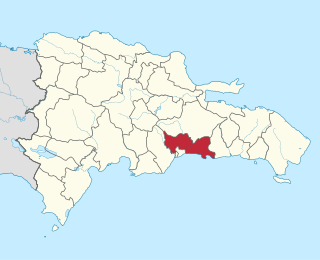
Santo Domingo is a province of the Dominican Republic. It was split from the Distrito Nacional on October 16, 2001.
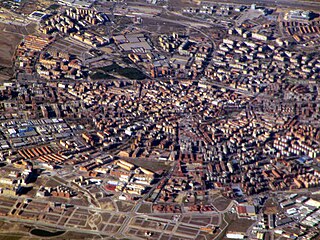
Móstoles is a municipality of Spain located in the Community of Madrid. With over 200,000 inhabitants, it is the region's second most populated municipality after Madrid. Móstoles was a small town for a long time, but expanded rapidly in the second half of the 20th century.

A parroquia is a population entity or parish found in the autonomous communities of Galicia and Asturias in northwestern Spain. They are entities with a territorial scope lower than municipality and have their own legal personality. They usually, but not always, coincide with the ecclesiastic divisions, as they originated on par with them.
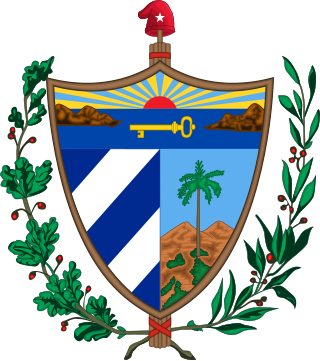
The provinces of Cuba are divided into 168 municipalities. They were defined by Cuban Law Number 1304 of July 3, 1976 and reformed in 2010 with the abrogation of the municipality of Varadero and the creation of two new provinces: Artemisa and Mayabeque in place of former La Habana Province.

Sargentes de la Lora is a municipality located in the province of Burgos, Castile and León, Spain. According to the 2004 census (INE), the municipality has a population of 196 inhabitants.
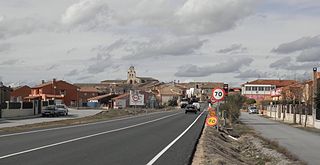
Santa María la Real de Nieva is a municipality located in the province of Segovia, Castile and León, Spain, about 30 km (18 mi) northwest of Segovia town. According to the 2010 census (INE), the municipality had a population of 1,193 inhabitants.
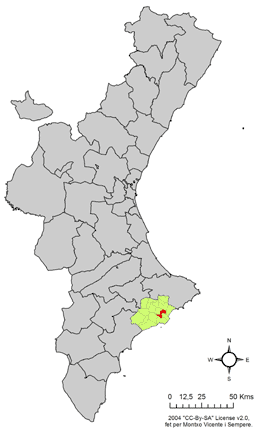
La Nucia is a municipality in the comarca of Marina Baixa, Alicante, Valencian Community, Spain. It borders the municipalities of Altea, Callosa d'En Sarrià, Benidorm, Polop and L'Alfàs del Pi.

Arcos de la Llana is a Spanish town and municipality in the province of Burgos, Castilla la Vieja, in the autonomous community of Castilla y León (Spain), the region of Alfoz de Burgos, the judicial district of Burgos, and head of the city council of Arcos de la Llana.

Cartagena is a Spanish city and a major naval station on the Mediterranean coast, south-eastern Iberia. As of January 2018, it has a population of 218,943 inhabitants. This makes Cartagena Murcia's second-largest municipality and Spain's sixth-largest city that is not a provincial-capital. The wider urban or metropolitan area of Cartagena, known as Campo de Cartagena, has a population of 409,586 inhabitants.


















